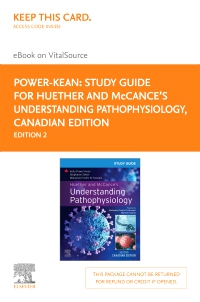
Study Guide for Huether and McCance's Understanding Pathophysiology, Canadian Edition Elsevier eBook on VitalSource (Retail Access Card), 2nd Edition
Elsevier eBook on VitalSource - Access Card

Choose the Canadian workbook that offers a direct path to understanding pathophysiology! Corresponding to the chapters in Huether and McCance's Understanding Pathophysiology, 2nd Canadian Edition, this study guide uses a variety of exercises, activities, and review questions to help your students master pathophysiology concepts. Case studies help students put the information together and develop critical thinking and clinical judgement skills. With new Next Generation NCLEX®-style practice questions, this study tool prepares students for success on the NGN examination and in clinical practice.
-
- NEW! The only Canadian nursing pathophysiology study guide on the market allows students to more fully grasp and apply complex pathophysiology concepts.
- NEW! NGN case studies include questions to help students in applying pathophysiology concepts and preparing for the NGN examination, with suggested answers included at the back of the book.
- Wide range of engaging activities allows students to assess their knowledge or identify areas for further study with matching definitions, choosing correct words, completing sentences, categorizing clinical examples, explaining pictures, describing differences, and teaching others about pathophysiology.
- More than 2,600 interactive questions in a variety of formats help students review and truly master high-level pathophysiology content.
- Case scenarios feature brief, real-world case studies with short answer-style questions.
- Teach People About Pathophysiology questions ask students to respond to questions posed directly from the patient’s point of view.
- Active headings break up question types with impactful language such as Match these Definitions instead of Matching or Respond to these Clinical Situations instead of Short Answer.
- Close alignment with the format of the Huether and McCance's Understanding Pathophysiology text make it easy to go back and forth between the two resources.
- Images from the main textbook are used in Explain the Pictures and Draw Your Answers questions to boost visual learning.
- Answer key found in the back of the study guide allows students to check answers and evaluate their progress.
-
- NEW! The only Canadian nursing pathophysiology study guide on the market allows you to more fully grasp and apply complex pathophysiology concepts.
- NEW! Next Generation NCLEX® (NGN) case studies include questions to help you apply pathophysiology concepts and prepare for the NGN examination, with suggested answers included at the back of the book.
-
Unit 1: The Cell
1. Cellular Biology
2. Genes and Genetic Diseases
3. Epigenetics and Disease
4. Altered Cellular and Tissue Biology
5. Fluids and Electrolytes, Acids and Bases
Unit 2: Mechanisms of Self-Defense
6. Innate Immunity: Inflammation and Wound Healing
7. Adaptive Immunity
8. Infection and Defects in Mechanisms of Defense
9. Stress and Disease
Unit 3: Cellular Proliferation: Cancer
10. Biology of Cancer
11. Cancer Epidemiology
12. Cancer in Children and Adolescents
PART TWO: BODY SYSTEMS AND DISEASES
Unit 4: The Neurologic System
13. Structure and Function of the Neurologic System
14. Pain, Temperature, Sleep, and Sensory Function
15. Alterations in Cognitive Systems, Cerebral Hemodynamics and Motor Function
16. Disorders of the Central and Peripheral Nervous Systems and Neuromuscular Junction
17. Alterations of Neurologic Function in Children
Unit 5: The Endocrine System
18. Mechanisms of Hormonal Regulation
19. Alterations of Hormonal Regulation
Unit 6: The Hematologic System
20. Structure and Function of the Hematologic System
21. Alterations in Hematologic Function
22. Alterations of Hematologic Function in Children
Unit 7: The Cardiovascular and Lymphatic Systems
23. Structure and Function of the Cardiovascular and Lymphatic Systems
24. Alterations of Cardiovascular Function
25. Alterations of Cardiovascular Function in Children
Unit 8: The Pulmonary System
26. Structure and Function of the Pulmonary System
27. Alterations of Pulmonary Function
28. Alterations of Pulmonary Function in Children
Unit 9: The Renal and Urologic Systems
29. Structure and Function of the Renal and Urologic Systems
30. Alterations of Renal and Urinary Tract Function
31. Alterations of Renal and Urinary Tract Function in Children
Unit 10: The Reproductive Systems
32. Structure and Function of the Reproductive Systems
33. Alterations of the Female Reproductive System
34. Alterations of the Male Reproductive System
Unit 11: The Digestive System
35. Structure and Function of the Digestive System
36. Alterations of Digestive Function
37. Alterations in Digestive Function in Children
Unit 12: The Musculoskeletal and Integumentary Systems
38. Structure and Function of the Musculoskeletal System
39. Alterations of Musculoskeletal Function
40. Alterations of Musculoskeletal Function in Children
41. Structure, Function, and Disorders of the Integument
42. Alterations of the Integument in Children
43. Co-morbidity and Multi-morbidities



 as described in our
as described in our 